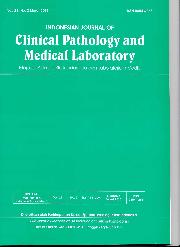Indonesian Journal of Clinical Pathology and Medical Laboratory
ISSN 0854-4263
Vol. 21 / No. 2 / Published : 2015-03
Order : 10, and page :158 - 161
Related with : Scholar Yahoo! Bing
Original Article :
Aspergillus glaucus group and penicillium sp in neurosurgery operating theater
Author :
- Nurul Hasanah*1
- Nurhayana Sennang*2
- Benny Rusli*3
- Bagian Ilmu Patologi Klinik FK UNHAS–BLU RS DR Wahidin Sudirohusodo
- Bagian Ilmu Patologi Klinik FK UNHAS–BLU RS DR Wahidin Sudirohusodo
- Bagian Ilmu Patologi Klinik FK UNHAS–BLU RS DR Wahidin Sudirohusodo
Abstract :
Nosocomial infections occur widely in the world, most of them were in the poor and developing countries, because those infection diseases were still the mayor cause of high morbidity and mortality. All microorganisms including fungi may cause nosocomial infection. The fungal as opportunistic pathogens can threat immunocompromised patients such as neurosurgical patients and HIV/AIDS patients. The aim of this study was to identify the fungal species found in the neurosurgery and HIV/AIDS rooms at Dr. Wahidin Sudirohusodo Hospital Makassar. This study was a cross sectional study. The sample was the air in neurosurgery operating theater and HIV/AIDS ward collected using Micro biology Air Sampler 100. The identification of fungal species using lacto phenol cotton blue stain were done in Balai Besar Laboratorium Kesehatan Makassar in the period of June up to July 2010. The amount of fungal colonies in the neurosurgery room was 36 CFU/m3 and the identified fungi were Aspergillus’s glaucus group and Penicillum sp. The amount range of fungal colonies in HIV/AIDS ward were 102–158 CFU/m3 and the identified fungi were: Aspergillus’s Niger, Aspergillus’s glaucus group and Penicillium sp. Based on this study it can be concluded that only Aspergillus’s glaucus and Penicillium sp were found in the neurosurgery operating theater and HIV/AIDS ward, while Aspergillus’s Niger was only found in the HIV/AIDS ward. Infeksi nosokomial banyak terjadi di seluruh dunia dan kejadian yang terbanyak adalah di Negara miskin dan sedang berkembang, karena penyakit tersebut masih merupakan penyebab utama angka kesakitan dan kematian tinggi. Semua mikroorganisme termasuk jamur dapat menyebabkan infeksi nosokomial. Jamur penyebab penyakit yang oportunistik dapat mengancam jiwa pasien imunokompromis misalnya di pasien bedah saraf dan HIV/AIDS. Penelitian ini bertujuan untuk mengetahui jumlah koloni jamur dan mengidentifikasi galurnya yang terdapat di Ruang Operasi Bedah Saraf dan Ruang Perawatan HIV/AIDS RS. Dr. Wahidin Sudirohusodo Makassar secara perhitungan. Penelitian dilakukan secara potong silang. Sampel adalah udara di Ruang Operasi Bedah Saraf dan Ruang Perawatan HIV/AIDS menggunakan alat Microbiology Air Sampler 100. Identifikasi jamur menggunakan pewarnaan lactophenol cotton blue dilakukan di Balai Besar Laboratorium Kesehatan Makassar (antara bulan Juni−Juli 2010). Jumlah koloni jamur di Ruang Operasi Bedah Saraf adalah 36 CFU/m3 dan jamur yang teridentifikasi adalah Aspergillus glaucus group dan Penicillium sp. Jumlah koloni jamur yang terdapat di ruang perawatan HIV/AIDS berkisar antara 102−158 CFU/m3 dan yang teridentifikasi adalah: Aspergillus niger, Aspergillus glaucus group dan PenicillIum sp. Didasari telitian ini dapat disimpulkan bahwa Aspergillus glaucus dan Penicillium sp hanya ditemukan di Ruang Operasi Bedah Saraf dan Ruang Perawatan HIV/AIDS, sedangkan Aspergillus niger khusus terdapat di Ruang Perawatan HIV/AIDS.
Keyword :
Nosocomial infection, aspergillus’sniger, aspergillus’s glaucus group, penicillium sp,
References :
Darmadi,(2008) Cara Penyebaran dan Sifat Penyakit Infeksi. Dalam: Infeksi Nosokomial: Problematika dan Pengendaliannya 5–6 : Salemba Medika
Cheng NC, et al,(1998) Unusual pulmonary Manifestations of Disseminated Penicilliummarneffei Infection in Three AIDS patiens vol 36 Hal: 429–32. : Med Mycol
Archive Article
| Cover Media | Content |
|---|---|
 Volume : 21 / No. : 2 / Pub. : 2015-03 |
|













